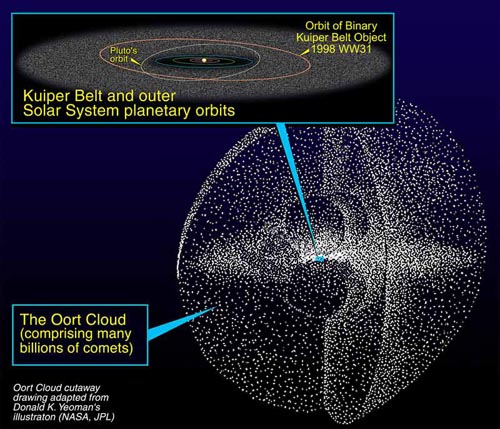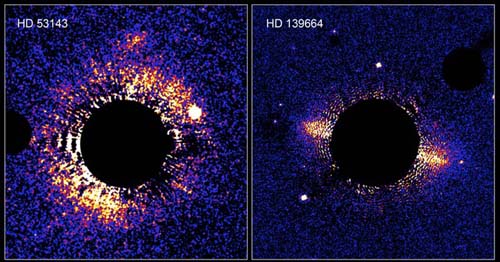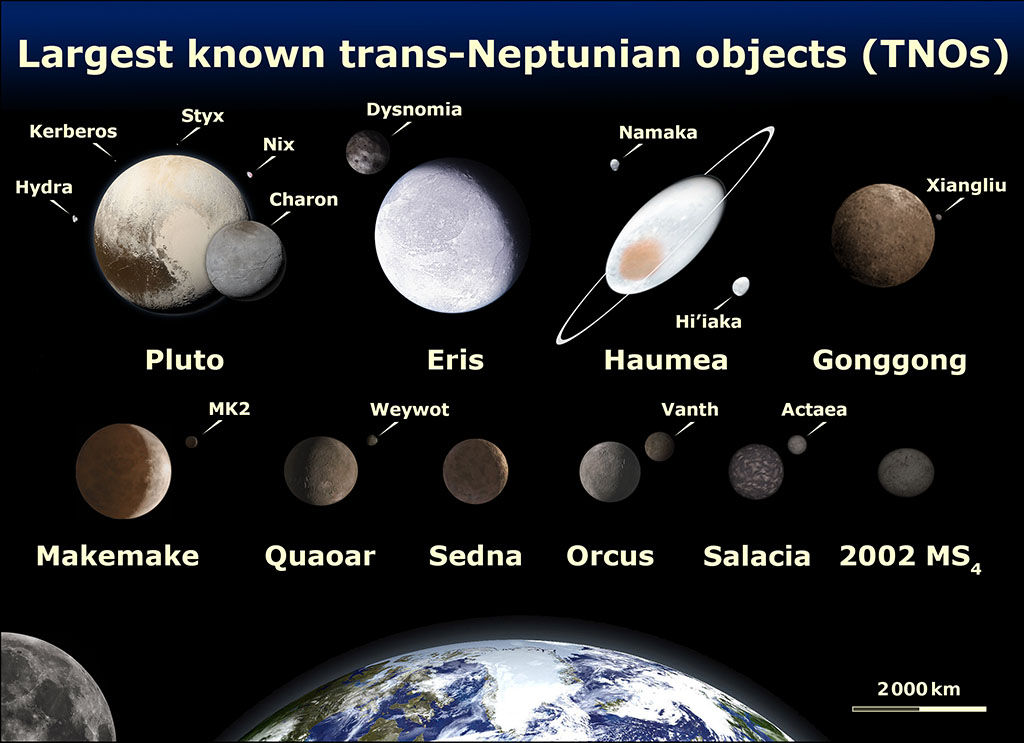

Kuiper Belt
It is a region beyond Neptune, populated by an estimated 10 billion to a trillion bodies of ice and rock known as Kuiper Belt Objects or also as Trans-Neptunian Objects (KBO or TNO). It ranges from 30 AU (Astronomical Unit = the average distance from the Earth to the Sun) to at least 150 AU away from the Sun and is believed to form a flattened interior extension of the Oort Cloud.
The Kuiper Belt is an older structure than the spherical part of the Oort Cloud. The KBOs or TNOs formed rather at their current locations - far enough away that they would not have been thrown by the giant planets - while the more distant objects in the Oort Cloud formed closer to the Sun than the TNOs, from where they were launched into their enormous current orbits by gravitational interaction with Jupiter and the other gas giants.

Oort Cloud and Kuiper Belt scheme - NASA/JPL
This belt is named after Gerard Kuiper (1905-1973), a Dutch American astronomer, who predicted its existence in 1951, although an amateur British astronomer, Kenneth Edgeworth (1880-1972), suggested its existence 9 years earlier. For this reason, from time to time, it is also referred to as the Edgeworth-Kuiper Belt.
The first verification observation of the Kuiper Belt came in 1992, when David Jewitt and Jane Luu (University of Hawaii and Berkeley) discovered a 200 km object wide circling the Sun, beyond the orbit of Pluto. Since then, many of these objects have been discovered. Estimates suggest that there may be more than 70,000 TNOs with a diameter of 100 km. in the region near Pluto's orbit and possibly more past 50 AU.

These debris disks around the two remote stars seem equivalent of our own Solar system's Kuiper Belt.
The left image is the "top view", and the right image "edge view". The black central circle is produced by
the camera's coronagraph which hides the central star to allow the much fainter disks to be seen.
Observed with Hubble Space Telescope.- NASA/JPL/HST
TNOs, very important because they represent original samples of the base material of the nebula from which the Solar System formed, are not evenly distributed in space. Once astronomers began discovering them in the early 1990s, one of the first surprises was that TNOs could be grouped according to the shapes and sizes of their orbits. This led scientists to understand that there are several distinct groupings or populations of these objects whose orbits provide clues to their history. The category an object belongs to has everything to do with how it has interacted with Neptune's gravity over time.
Hence, the classification of TNOs is due to their location in the Kuiper Belt, their relationship with Neptune, and their orbit.
TNO classics
A large fraction of TNO orbit the Sun in what is called the classical Kuiper belt. The term "classic" refers to the fact that, among TNOs, these objects have orbits more similar to the original, or classical, idea of what the Kuiper Belt was expected to look like, before astronomers began to find objects there. (They were expected to be in relatively circular orbits that aren't tilted too much from the plane of the planets. Instead, many TNOs are found to have significantly elliptical and tilted orbits)
There are two main groups of objects in the classical Kuiper belt, called "cold" and "hot." These terms do not refer to temperature, but rather describe the orbits of objects, along with the amount of influence Neptune's gravity has had on them.
All classic TNOs have a similar mean distance to the Sun, between 40 and 50 AU. Cold classic KBOs have relatively circular orbits that are not very far from the plane of the planets; Hot classic TNOs have more elliptical and tilted orbits.
The differences between these two body types in the classical Kuiper belt have everything to do with Neptune. The cold classic TNOs have orbits that never come very close to Neptune, and thus remain "cold" and unperturbed by the giant planet's gravity. In contrast, hot classical TNOs have had gravitational interactions with Neptune in the past. These interactions pumped energy into their orbits, stretching them into an elliptical shape and tilting them slightly out of the plane of the planets.
Resonant TNOs
A significant number of TNOs are in orbits that are tightly controlled by Neptune. They orbit in resonance with the giant planet, as they complete a specific number of orbits in the same amount of time that Neptune completes a specific number of orbits. For example, Pluto is in a 3: 2 resonance with Neptune, which means that it orbits the Sun twice for every three times Neptune goes around.
Scattered disk
The scattered disk is a region that extends far beyond the main part of the Kuiper Belt and houses objects that have been scattered by Neptune into orbits that are highly elliptical and inclined to the plane of the planets. Many Scattered Disk Objects have inclined orbits tens of degrees. Some venture hundreds of AU from the Sun and high above the plane of the planets at the farthest point in their orbits, before returning to the closest point near the orbit of Neptune.
Eris is an example of a scattered disk object in addition to being the largest known member of this population.
Detached objects
The objects detached from the Kuiper Belt have orbits that never come closer to the Sun more than 40 AU. This distinguishes them from most other TNOs, which spend at least part of their orbits in the region between 40 and 50 AU from the Sun. Because their orbits do not come close to Neptune's distance from the Sun (~ 30 AU), detached objects seem unlikely to have been pulled out of the Kuiper Belt by interactions with the giant planet. Scientists think that some other force is likely to be responsible, such as an undiscovered giant planet (in a very distant orbit), the gravity of passing stars, or gravitational perturbations as the Kuiper Belt was forming long ago.
Sedna is an example of a detached TNO. The closest it comes to the Sun is 76 AU, while at its farthest it travels out to 1,200 AU.
Centaurs
Centaurs are objects with orbits that travel through space between the orbits of Jupiter and Neptune (see Asteroids). In these orbits, they interact strongly with the gravity of the giant planets. Due to these powerful gravitational encounters, most are fated to either be ejected from the solar system or pushed into the inner solar system where they become comets or collide with the Sun and planets.
The process of removing centaurs is ongoing, and it only takes tens of millions of years for a typical centaur object. Therefore, the fact that there are centaurs around today is evidence that they are being actively supplied from elsewhere. Astronomers think the most likely explanation is that they are relatively recent escapees from the Kuiper Belt. In fact, centaurs are understood to be scattered objects, like those in the scattered disk, with the difference that the centaurs have been scattered closer to the Sun by Neptune, rather than farther out.
Scientists have now concluded that the Kuiper belt is slowly eroding. The objects that remain there occasionally collide, producing smaller objects fragmented by the collision, sometimes comets, and dust that is blown out of the solar system by the solar wind.

Comparison of the 10 largest known trans-Neptunian objects (TNOs) by 2021. Eight of these TNOs are known to have satellites. Gonggong is currently estimated to be larger than Makemake and smaller in diameter than Haumea's major axis, although it is smaller in volume. NASA, ESA, and A. Feild (STScI)
Information from: David Darling's encyclopedia and Solar System Exploration-JPL-NASA.
2021 update information: NASA
Dwarf Planets
Eris takes her name from the goddess of discord in Greek mythology. Totally appropriate name since the 2003 discovery UB313, as it was initially designated, was the last straw in the debate over which bodies should be considered planets and which ones should not. At that time it was considered that Eris was larger than Pluto (later it was confirmed that it was somewhat smaller), therefore it should be considered a planet, but then there were other somewhat smaller bodies in a similar situation, including Ceres, the largest of the asteroids, so the International Astronomical Union put an end to the discussion in August 2006, defining the definition of a planet and establishing a new category of bodies in the solar system that it called "Dwarf Planets", in which they would be grouped, once recognized, all these recently discovered objects, known as Trans-Neptunians or KBOs.
Pluto stopped being considered the ninth planet to become the second largest of the dwarf planets and prototype of a new class of Trans-Neptunian object: "plutinos".
Later, with the data obtained by New Horizons, Pluto finally remained as the largest Dwarf Planet.
The definitions were like this:
Planet:
It is a celestial body in orbit around the Sun (or star) with enough mass so that by its own gravity it acquires a shape in hydrostatic equilibrium (spherical or hemispherical) and has cleared the surroundings around its orbit.
Dwarf planet:
It is a celestial body in orbit around the Sun (or star) with enough mass so that by its own gravity it acquires a form in hydrostatic equilibrium (spherical or hemispherical) and that has not cleared the surroundings around its orbit and is not a satellite of another body.
All other objects that do not fall within the above definitions, except satellites, are now collectively designated as "Small Solar System Bodies" (SSSB) and in particular those objects similar to dwarf planets, but without confirmation, they are designated minor planets.
Actually Dwarf planets are 5:
Pluto
Eris
Haumea
Makemake
Ceres